The post Coming in 2026: A New, Easier Way to Submit TQIP Data appeared first on ESO.
]]>What’s changing?
Instead of manually uploading files, healthcare facilities will be able to submit data directly from their trauma registry software to the TQIP Data Center. This new process is designed to:
- Improve data quality and timeliness
- Reduce administrative workload
- Streamline your workflow
ESO is ready and here to help.
We’ve been working closely with the ACS to prepare for this transition. Our team already has the technical requirements and is actively developing the necessary updates to support the new process in 2026.
What does this mean for you?
Here are answers to some common questions:
- Which ESO products will support the new submission process?
Only ESO Patient Registry will be updated to support the new TQIP submission process in 2026. Legacy patient registry products (CDM, DI, and Lancet by ESO) will not be updated to support this new process for 2026 submissions.
- Can I still use my legacy registry for TQIP submissions in 2026?
Yes. You will be able to continue submitting TQIP data using your current legacy product in 2026. We have confirmed with the ACS that the existing submission portal will remain available, so your current manual process will not change. The ACS is aware that we are not updating the legacy registry products.
The ACS recently communicated that although the current manual process will continue to be an acceptable data submission method, they cannot guarantee that the option will be available beyond 2026. Please be assured ESO will continue collaborating closely with the ACS throughout this transition to ensure our legacy patient registry customers are represented in future decisions.
- Do I need to do anything now?
No immediate action is required. But if you’re interested in upgrading to ESO Patient Registry to take advantage of the new streamlined process, fill out this form and a member of our team will reach out to you.
Stay in the loop
We’ll keep you updated throughout the year with everything you need to know. Check your inbox for more details as we move closer to launch.
The post Coming in 2026: A New, Easier Way to Submit TQIP Data appeared first on ESO.
]]>The post Why Whole Blood Is Gaining Ground in Trauma Care appeared first on ESO.
]]>As trauma teams push to improve survival, one intervention is gaining renewed attention: whole blood.
The U.S. military started using whole blood in World War I, but it fell out of favor with blood component availability. Military air evacuations revived whole blood use in the early 2000s, and by 2016, most civilian air medical services carried it. Since then, whole blood use has steadily grown, especially in high-volume and Level I trauma centers.
The 2024 ESO Trauma Index offers a detailed analysis of current trends and benchmarks in trauma care, setting a new standard for improvement and allowing healthcare professionals to get a closer look at the data, understand its impact, and explore best practices for enhancing patient outcomes. Pulling data from the world’s largest de-identified trauma registry data program, the Index’s insights reflect over 975,433 trauma patient records that took place between January 1 and December 31, 2023. One of the key metrics covered in the Trauma Index is whole blood usage.
Key Findings
The 2024 ESO Trauma Index, for the first time, looked at all patients who received blood/blood products. Some of the key findings include:
- Among the almost 70,000 trauma patients who received a blood transfusion, 5% received whole blood only, 87% received packed red blood cells (PRBCs), and 8% received both whole blood and PRBCs.
- The median time to whole blood delivery among all patients who received whole blood was 13 minutes. That’s good news.
- For patients who met the Early Blood Transfusion Needs Score (EBTNS), a score of greater than five and received whole blood, 98% received whole blood within four hours, the goal.
- The median time to transfusion for trauma patients who received PRBCs was 12 hours. Considering that 87% of transfusion recipients receive PRBCs, 12 hours is concerning.
Are PRBCs Enough?
PRBCs remain a mainstay of trauma care. They help stabilize patients and support volume replacement during hemorrhage. But PRBCs alone can lead to over-resuscitation, clotting problems, or metabolic disturbances. The 2024 ESO Trauma Index shows that more than 50% of trauma patients arrive hypocalcemic.
The increase in EMS agencies and trauma centers administering whole blood is driven by military and civilian research showing that early whole blood transfusion can significantly improve outcomes for patients in hemorrhagic shock.
Key Recommendations from the 2024 ESO Trauma Index
Hospital trauma centers looking to strengthen transfusion practices should consider these best practices:
- Track and review all transfusions administered within three hours of injury.
- Monitor calcium levels during transfusion and provide supplementation.
- Implement or refine massive transfusion protocols.
- Administer TXA early, ideally within three hours of injury.
- Use point-of-care coagulation testing (e.g., TEG, ROTEM) to guide treatment.
- Develop rapid-access systems for blood products, even in non-critical scenarios.
Yet, for all its good, whole blood remains expensive and challenging to manage. For trauma centers committed to incorporating whole blood, hospitals and EMS partners should:
- Set clear protocols for blood handling, transfusion, and storage.
- Coordinate closely with trauma centers and blood banks to manage supply.
- Support community blood drives to maintain availability.
- Provide ongoing training to EMS professionals administering blood products.
Whole blood isn’t new, but its return is evidence-backed and outcome-driven. For trauma centers committed to faster intervention and better survival, it may be one of the most powerful tools available.
Want more whole blood benchmarks and guidance? Download the full 2024 ESO Trauma Index for the complete picture.
The post Why Whole Blood Is Gaining Ground in Trauma Care appeared first on ESO.
]]>The post Wave 2025 Recap: Top 5 Topics in Hospital and Trauma Care appeared first on ESO.
]]>1. Good data is the foundation
Providing consistent, high-quality care isn’t a one-person job; it’s a system-wide effort. At Wave 2025, speakers emphasized the value of collecting accurate data, sharing benchmarks, building feedback loops, and supporting providers with the information and education they need to act.
It’s been said that there are three kinds of falsehoods: a fib, a downright lie, and statistics. Dr. Remle Crowe and Ali Treichel from ESO want to ensure no one falls prey to the third one in session, Dogs and Data: A Cautionary Tail. They shared how to gauge the quality of study results, what statistical jargon means, and the importance of staying curious about results.
For fans of the show “Ted Lasso,” TowerDIRECT’s Jason Drinkwater, Paramedic V – Quality Coordinator, led a familiar-sounding session: Be Curious, Not Furious: A Data-Driven Approach to Change. Before jumping to fix a perceived problem, it’s imperative to ask questions of the right people. Always include frontline workers for valuable insight and buy-in. Otherwise, you know what happens when you assume.
2. Stay in step with change
Trauma care is a lifelong profession for many. Presenters shared experiences, best practices, and evidence-based research to spotlight ways to stay in step with trends and technology.
First responders – and indeed, all healthcare providers – must demonstrate their value to taxpayers, patients, employers, payers, city council, and more. In From Data to Impact: Proving the Value of the Services You Deliver, Matt Zavadsky, EMS/Mobile Healthcare Consultant at PWW Advisory Group, shared which types of data resonate with stakeholders and how to tailor information to satisfy each. The practical takeaway: “Value is based on who is writing the check.”
Leveraging the ESO Patient Registry During an American College of Surgeons Site Survey, presented by Matthew Derkrikorian, Trauma Program Manager at Rady Children’s Hospital, offered a look at how Rady Children’s Hospital prepared for and completed the first ACS Site Survey using ESO’s updated registry.
Next, for trauma centers wondering how their performance compares nationally, ESO’s Dr. Tony Fernandez shared findings from the 2024 ESO Trauma Index in Benchmarking Care for Quality Improvement. Download the report for new insights and best practices. It’s a valuable tool to spark quality improvement conversations.
In Sepsis Treatment: Good for the Patient and the Payor, Erik Axene, CEO and Founder of Axene Continuing Education, updated attendees on trends and evidence, including artificial intelligence (AI) and machine learning solutions, trying to get ahead of this deadly issue.
Building Resilience: The Power of Standardization in Navigating Change showed how CommonSpirit Mountain Region approached a trauma registry upgrade by centralizing and standardizing operations. Melissa Sorensen, RN Trauma Registry Manager, shared how the process built collaboration and positioned the team to adapt effectively.
3. Culture that supports improvement
Many sessions acknowledged a hard truth: data alone isn’t enough. Change happens when organizations build a culture that embraces reflection, transparency, and learning.
Brooke Burton, Quality Improvement Manager at Unified Fire Authority, led Mistake or Murder: What Can EMS and Hospitals Learn from the Vanderbilt Case? The in-depth examination showed how hospital culture contributes to patient and worker trust.
Scott Bourn from ESO led a practical session, Strategies for Influencing Change Using Data, reminding us that how you use data and information matters. If statistics were enough, no one would smoke! Knowing how to influence without judgment is crucial for improving internal hospital culture and providing supportive patient care.
A Call to Action: Amplifying the Roles of the Level III and Level IV Trauma Centers, led by Kelli Vaughn, Trauma Program Manager at John D. Archbold Memorial Hospital, detailed how Georgia’s smaller trauma centers, long excluded from larger system initiatives, created a standing committee to shape care across all levels of trauma care. .
Finally, Michael Kaduce, Director at The Falck Health Institute, addressed the challenge of how to start a quality improvement project. Once your hospital team has data in hand and leadership on board, pick something low-cost and high-impact. He provided ideas, examples, and tools in Bringing Research to Frontline Providers: Supporting Your Quality Management Program.
4. EMS-hospital collaboration improves outcomes
Multiple sessions focused on the continuum of care. Hospitals that make real-time data accessible to EMS agencies and close the loop on outcomes see stronger relationships, better documentation, and improved patient care.
In the session From the Roadside to the Bedside to the Hospital Boardroom, Jonathan Sague, Regional Chief Operating Officer, shared how University Hospitals (UH) are redefining EMS-hospital collaboration. By treating EMS as partners and sharing timely data and feedback, UH improved care transitions, documentation quality, and frontline morale. As a bonus, stronger EMS relationships can increase patient volume, which leads to financial gains and hospital growth.
Next, Justin Nelson, EMS Liason at VHC Health, shared their experiences with ESO Health Data Exchange (HDE) in The Bridge to Better Patient Outcomes. Instead of three separate interfaces plus encrypted email to communicate with EMS agencies, VCH only uses HDE. Stronger EMS relationships translated into a 7% increase in volume, and 91% of patient records match – up from 18%.
In A Healthcare Shift: How Virtual Nursing and Hospital at Home Programs Are Changing The Landscape of Patient Care, Lisa Meyer from ESO examined how virtual care is reshaping patient interaction models – and what that means for EMS and hospital alignment moving forward.
5. Challenge precedent
In a conference centered on using data, multiple sessions tackled common beliefs and techniques that no longer serve trauma care.
In the popular Hot Topics in Trauma Care, experts Dr. Glen Tinkoff, System Chief, Trauma and Acute Care Surgery at University Hospitals, Dr. Samir Fakhry, VP for Center for Trauma and Acute Care Surgery at HCA, and ESO’s Dr. Brent Myers examined evidence on trending issues in trauma care. High points included:
- Delaying surgery to ‘tune up’ patients doesn’t help, as COPD won’t be cured in three days.
- Blame pickleball for the increase in geriatric falls.
- There is enough data to support whole blood use in trauma. But haven’t solved delivery or replenishment.
- Not all traumas require a full trauma activation.
- Prepare for increased pediatric behavioral health and pediatric gun violence.
Next, in Ketamine Therapy for the Wounded Helper, Dr. Alexandra Jabr, Educator at Emergency Resilience, shared research and personal experiences with Ketamine as part of a holistic approach to PTSD. She presented evidence and distinguished medical versus recreational use, while addressing its limited FDA approval and credibility.
Taking aim at hospital-wide issues like overcrowding, burnout, and boarding in It’s Everyone’s Problem: The Ongoing Challenge of Patient Flow and Capacity Constraints, Lisa Meyer from ESO shared tactics hospitals are deploying to reduce adverse events and improve patient movement.
Configuring Your Trauma Registry for Successful Reporting and Performance Improvement featured Lee Ann Wurster, Trauma and Burn Program Manager at Nationwide Children’s Hospital, who detailed how intentional registry setup and onboarding helped maintain real-time abstraction and continuous reporting.
Stay ahead of what’s trending in the industry.
Our data experts at ESO compiled a few resources to help you keep up with a shifting industry while using aggregated data to ensure your organization stays at the top of its game. Check out the 2024 ESO Trauma Index to see where your organization stands against national benchmarks in important metrics.
It’s not too early to start thinking about Wave 2026!
Mark your calendars for April 7-10, 2026, to join us in Austin, TX, for four days of thought leadership, networking, and learning. If you’re interested in being the first to get the inside scoop on what data-driven advancements and technologies are trending industry-wide, mark your calendars and stay tuned to register.
The post Wave 2025 Recap: Top 5 Topics in Hospital and Trauma Care appeared first on ESO.
]]>The post (Q1/2025) ESO Updates: Quarterly Product Enhancements appeared first on ESO.
]]>Content applicability by product
| Building Blocks | EMS | Fire | Hospital | State |
| ESO Suite | Login Update | X | X | X | X |
| Fire Incidents | NERIS Beta | X | |||
| EHR | iOS General Availability | X | |||
| EHR | Stryker LIFEPAK 35 General Availability | X | |||
| Logis Dispatch / EHR | Integrations for MIH | X | |||
| Patient Registry | Bulk Procedure Entry | X | |||
| Patient Registry | FHIR Integration for Cerner | X | |||
| PM | Compensation (Payroll) Update | X | |||
| Assets | Preventive Maintenance Foundations | X | X | ||
| ODL | Content Development and GenAI | X | X | X | X |
| Data Platform | Sisense upgrade | X | X | X | X |
| Data | Direct shares | X | X | X | X |
| Insights | Global dashboards | X | X |
ESO Suite Login Update
We are excited to unveil the latest update to the ESO Suite Login. This enhancement streamlines the login process, offering you a more intuitive and secure experience. With improved authentication methods and faster access, you can now effortlessly log in to the ESO Suite, ensuring less time spent on administrative tasks and more time providing quality care.
This update reflects our ongoing commitment to optimizing user experience and enhancing the efficiency of healthcare operations. Stay tuned for more updates as we continue to innovate and improve our product offerings to better serve the healthcare community.
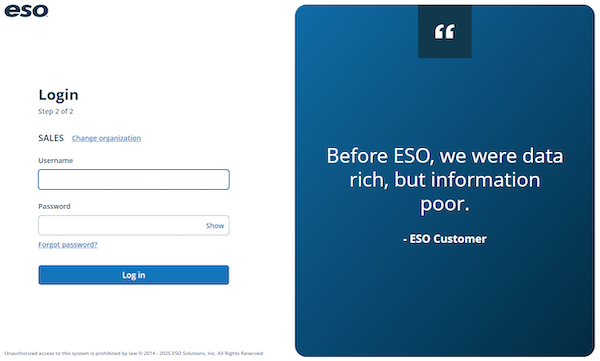
Fire Incidents | ESO NERIS Beta Program
NERIS Fire Incidents Beta Program
In early March, we launched our closed beta program, which allows a select group of agencies to access, train, and experience the brand new NERIS-compliant Fire Incidents. In turn, the agencies in the beta program are providing valuable feedback to help us refine and improve the application further. The beta program includes features such as progressive disclosure, rich text editing for narratives, and GIS integration for address fields. We have encouraged the agencies involved to include both administrators and field responders in the testing process to gather diverse feedback and ensure the application meets the needs of all users in their transition to NERIS.
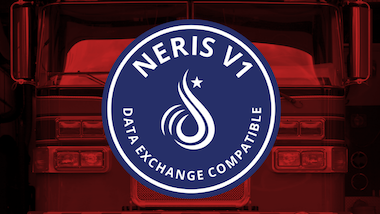
NERIS Data Exchange Compatibility Badge
We are proud to announce that ESO has officially received our NERIS Data Exchange Compatibility Badge, signifying that ESO Fire Incidents meets all new NERIS compliance requirements while maintaining ease of use, data accuracy, and intuitive reporting.
This badge signifies that you can feel confident in trusting ESO Fire Incidents to provide everything you need to smoothly transition to NERIS and stay ahead of the biggest change in fire reporting in the past 50 years. Moving forward, ESO will continuously enhance Fire Incidents while further integrating it with other applications within the ESO suite to ensure a comprehensive solution that continues to support the new NERIS standard while enhancing application capabilities and user experience.
EHR | iOS General Availability
EHR for iOS is now available to all, marking a major step forward for ESO. Designed to provide you with the proper tools to enhance patient care and quickly enter quality data, this latest release introduces Longitudinal Record (LR), Siri Integration, and Mobile to Mobile (M2M).
Built with the needs of first responders in mind, EHR for iOS offers a user-friendly interface, seamless integration with EHR Web and Windows Mobile, and robust security features to ensure patient data is protected.
Here are some key features to look out for:
- CAD & Cardiac Monitor Integration: The application supports integration with cardiac monitors and CAD systems, enhancing your ability to swiftly monitor and respond to patient needs. Supported cloud monitor integrations include Zoll Online (X Series), LIFENET System (LP 12, 15, and 35), and Philips IntelliSpace Corsium (Tempus ALS).
- Robust Security: EHR for iOS supports multi-factor authentication (MFA), Single Sign-On (SSO), and 6-digit Numeric PINs to support multiple crew members.
- Mobile Device Management: Agencies leveraging Mobile Device Management (MDM) to manage iOS devices in the field can now do so with a few additional steps.
- Medication Scanning: By using the device camera, patients’ medications can be added to their Medication list by scanning the prescription labels or lists of medications, saving your team precious time.
- Mobile to Mobile (M2M): Just like M2M is available with our Windows Mobile application, the EHR for iOS application supports the ability to send or receive data to and from a Windows Mobile or iOS device.
- Longitudinal Record (LR): Similarly to EHR for Web, EHR for iOS leverages our new Longitudinal Record feature to quickly look up and match patient information.
- Siri Integration: Activate Siri for hands-free entry of incident times and vital signs, as well as document flowchart treatments. It’s as simple as saying, “Hey Siri, capture pulse rate in EHR.”
Now available in the App Store, EHR for iOS has undergone rigorous testing and validation to ensure it meets the highest standards of performance and security, saving your team precious time in the field.
EHR | Stryker LIFEPAK 35 General Availability
Our latest integration with the Stryker LIFEPAK 35 monitor/defibrillator is now available for all and is designed to provide an enhanced user experience, boosted productivity, and access to the latest technologies. Thank you to the beta agencies who helped us ensure that this integration was ready for prime time.
Key Features of the LIFEPAK 35 Integration with EHR:
- Seamless Connectivity: Enjoy a user-friendly interface that makes it easy to connect Stryker LP 35 with ESO EHR. Experience improved performance that ensures smooth, uninterrupted data flow, allowing you to complete tasks more efficiently.
- Improved Patient Care: Focus on delivery of care with the ability to import data from the monitor to EHR, reduce documentation time, and improve your data’s accuracy.
- Dependability of Data: Use the strength of two trusted and dependable platforms in one high-quality solution.
Why Choose the LP 35 Integration?
Our integration with the Stryker LP 35 is designed to meet the needs of professionals who require reliable and efficient tools to manage their workflow. Whether you’re a responder in the field, an administrator, or a researcher, this integration offers you the functionality you need to be successful.
Patient Registry | Bulk Procedure Entry
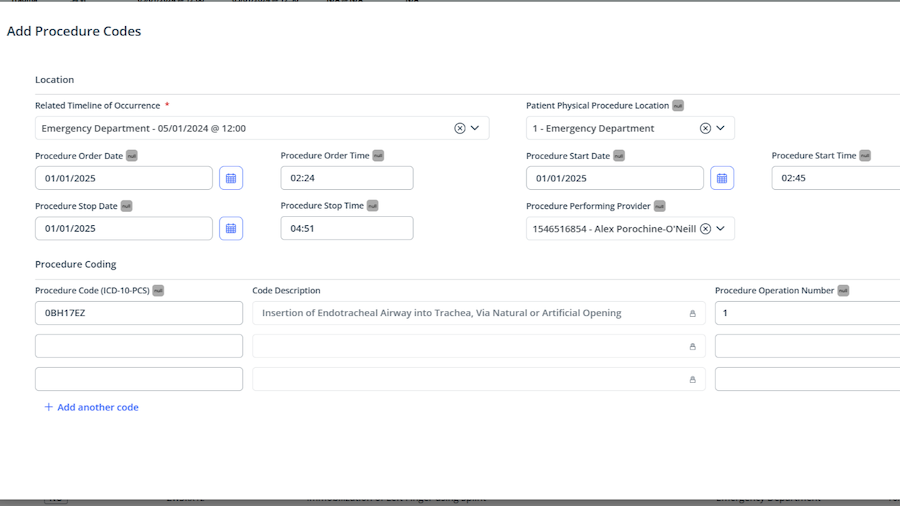
Through customer feedback and collaboration, ESO determined that enhancing bulk procedure entry was critical to the Patient Registry user experience. This update will significantly streamline daily operations by allowing your team to more efficiently manage and execute large volumes of procedures, reducing the administrative burden while improving workflow efficiency.
By automating routine tasks and enabling bulk processing, healthcare facilities can focus more on patient-centric activities, ensuring timely and accurate delivery of care. So far, we’ve already seen a 15% reduction in time on tasks and an 81% reduction in clicks to complete tasks. We hope that you find that this enhancement not only optimizes your resource utilization but also contributes to overall better patient outcomes and product satisfaction.
Patient Registry | FHIR Integration for Cerner

Building upon Patient Registry’s FHIR data integration with Epic, we extended the integration with Cerner to not only streamline your workflows but also enhance the overall efficiency and quality of your data. An ESO Admin page has also been launched that will allow facilities to self-configure their FHIR URLs and custom MRN identifiers.
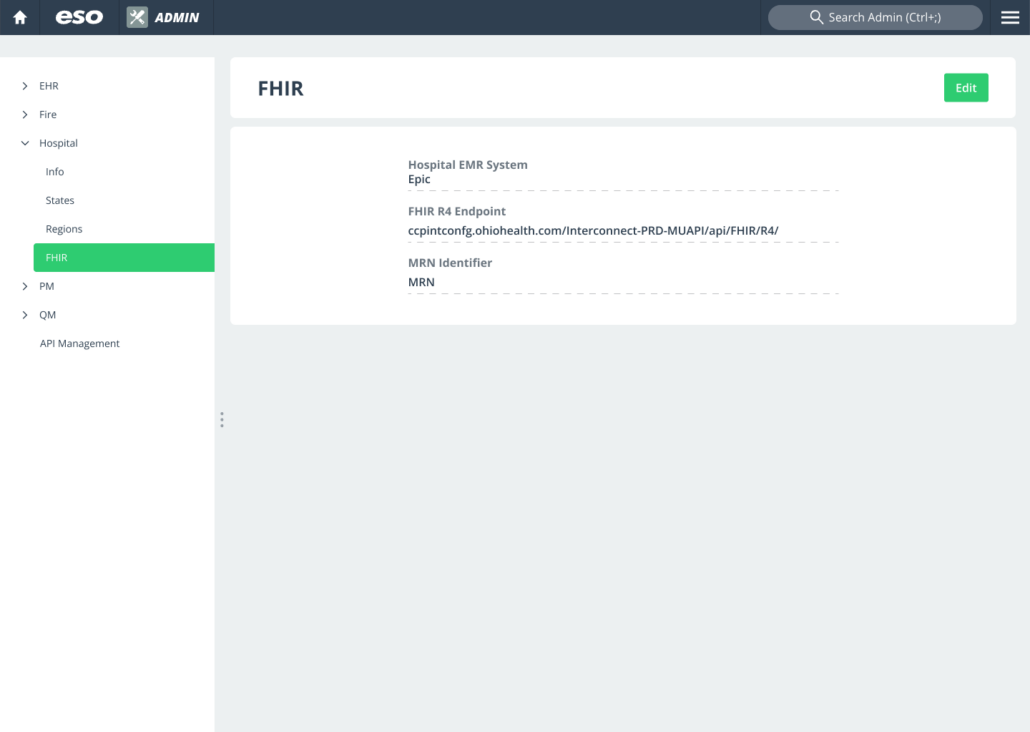
Stay tuned for more exciting updates on how the FHIR integrations will evolve and transform your Patent Registry experience!
Patient Registry | “No Bloods Given” Button
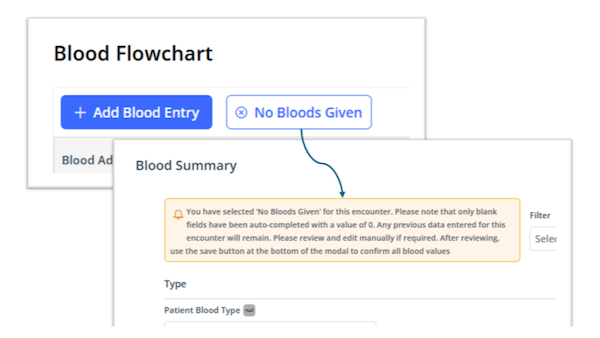
The new “No Blood” button feature on the “Blood” Flowchart section allows your team to directly interact with the “Blood Summary” modal without manually entering data field by field. This new update takes a process that originally took over 20 clicks down to just 2, saving your team vital time.
This feature was highly requested by Registry users who need to capture data for total blood and blood within 4 hours and has already been incredibly popular with users.
PM | Compensation (Payroll) Update
Development of the Compensation module is in full swing. This new module will cover payroll for volunteer, combination, and pay-per-call departments and can be used in conjunction with the Pay Rates feature. By enabling the Compensation module, organizations can integrate Fire Incidents into PM, along with creating and editing compensation definitions, adding and editing rules, managing employees, and exploring the pay period history page.
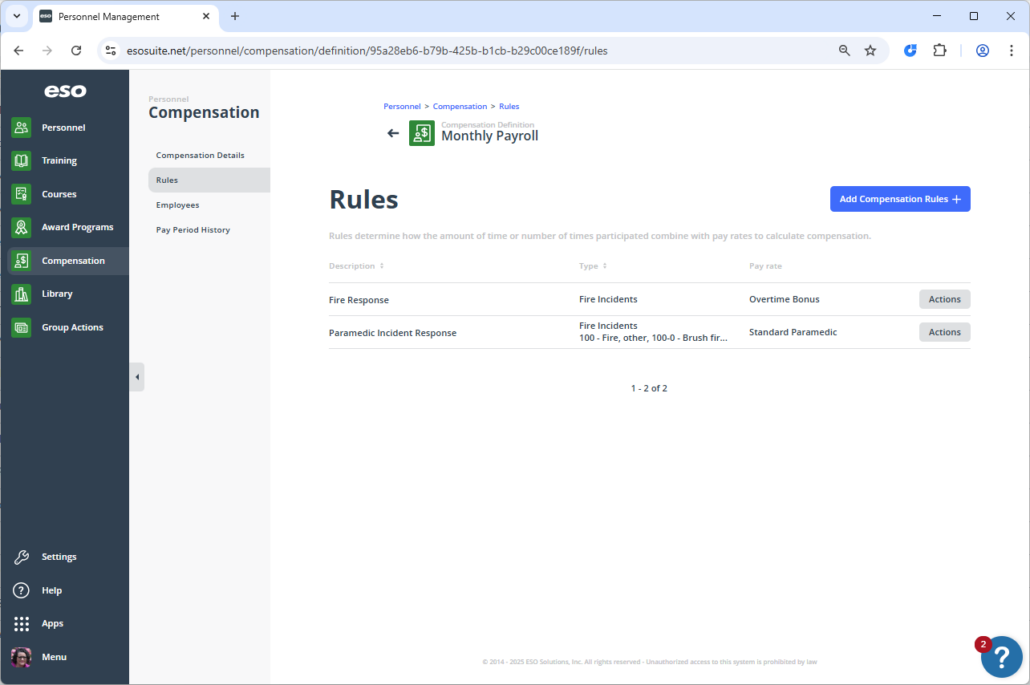
More exciting news: after our next release, your organization will be able to see live data on the pay period history page, view employees within the pay period, and dive into the calculation details, which means you can complete the entire cycle for rules based on Fire Incidents, right up to the export and finalization process. Stay tuned for more updates.
Assets | Preventative Maintenance Foundations
Asset Management has gone through several foundation updates to deliver a brand new end-to-end preventative maintenance functionality. Here are the updates that happened in Q1:
- Meter Readings in Equipment Profiles: Similar to what’s available in vehicle profiles, meter reading fields were added to the equipment profile to capture various readings.
- Maintenance Requests: When closing a maintenance request, you can now add current meter readings to the ticket, which will update the asset’s profile.
- Asset Spreadsheet Upload: Meter reading fields have been added to the upload spreadsheets to support importing current meter readings when onboarding to Assets.
These updates will allow you to enter meter readings in four different ways: by checklist submissions, maintenance requests, spreadsheet uploads, or direct edits to the asset profile.
The Maintenance Overview page has also been updated to support end-to-end preventive maintenance workflows. With the addition of Status, Complete Date, and Request Type columns, you can now quickly reference existing open requests and see whether a request was manually created or auto-generated.
Keep an eye out for the release of Maintenance Schedules, which will allow you to set recurring maintenance schedules based on odometer, engine hours, calendar, and more!
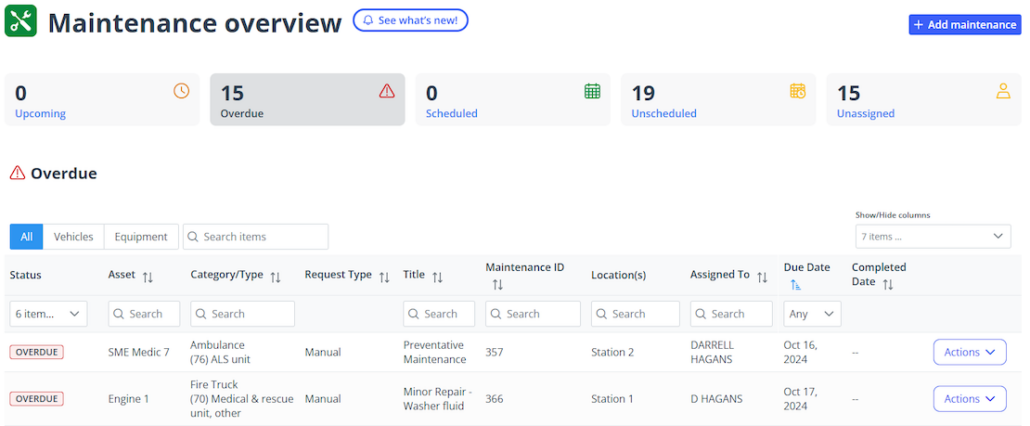
Data | Snowflake Direct Shares
ESO has released its latest data reporting and access capability – Snowflake Direct Shares. This new capability will allow you to seamlessly integrate ESO Suite reporting data into your own existing Snowflake account, as well as give you the capability to create customized queries and exports and combine ESO data with internal sources using your own data reporting tools. Eliminating the need for intermediary ETL tools, APIs, or other reporting platforms simplifies the data reporting ecosystem and reduces the management of additional credentials and access points.
Insights | Global Dashboards
A number of Global Dashboards were updated and released throughout Q1, but there are two groups of Dashboards we are particularly excited about:
EHR | WEMSIS Demographic Information Reporting Dashboards
A series of seven dashboards, the WEMIS Demographic Information Reporting Dashboards, are aimed at supporting WA customers who are required to report annual demographic data to WEMSIS. More information on the measures and submission can be found here.
State Repo NEMSIS 3.5 | California Core Test Measures
Five Global dashboard templates were released to support customers in CA regions and agencies by more accurately reflecting the specifications for the 5 CA core test measures for 2024 data (AIR-1, AIR-2, AIR-3, PED-4, & TRA-3). You can get more information here.
Cross-Product/ESO Suite | In-App Enhancements
In Q1, our UX and Personnel Management team launched our Pilot Ideas Portal in Personnel Management to make it even easier for our community to share feedback and gain insights into current product roadmap ideas. This portal is designed to enhance the collaboration process and make it easier for our product team to understand and solve our customers’ pain points. The pilot was a huge success with high adoption and engagement along with positive feedback. Last quarter alone, ESO received 2198 enhancement suggestions from our community, which is an increase of 33.4% from Q4!
Thank you for your continued hard work and dedication in helping us create tools to better support your team. We will continue to email you updates when viable ideas progress into the discovery, design, and development stages.
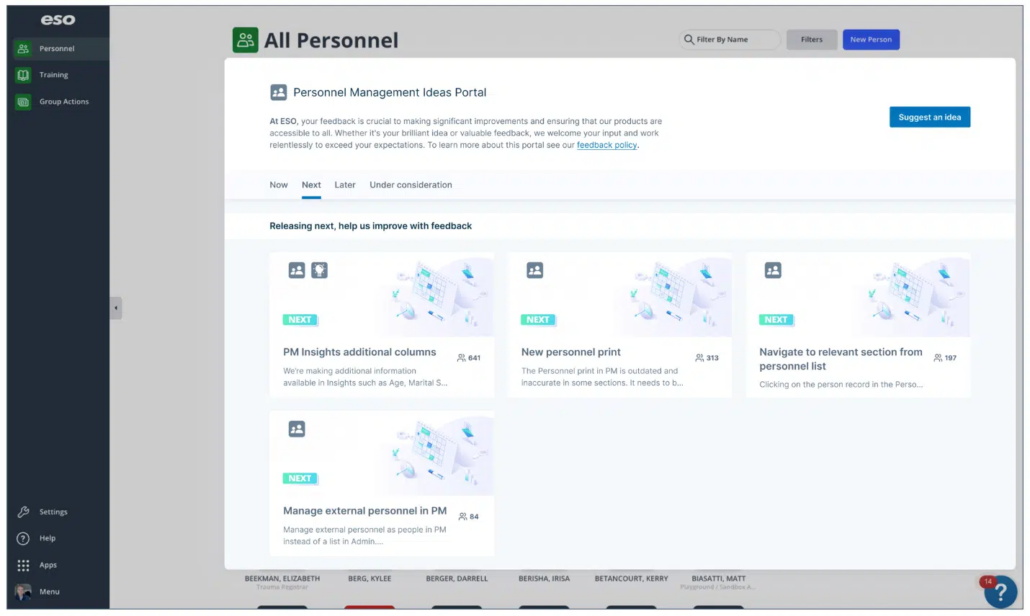
Stay turned for further rollout in the ESO Suite!
What to expect next
Here are a few more exciting enhancements currently in the works. Please stay tuned for release notes, but here’s a sneak preview of a few updates and enhancements we have planned:
EMS
- AI Generated Narrative for non-transport dispositions
- Additional availability in Windows mobile
- Our new iOS application
- Optional use of either SOAP or DCHARTE format
- NEMSIS critical patch for gender to maintain compliance with NEMSIS and presidential executive order
- New EHR Partner API
- Agency custom forms for beta
Fire
- NERIS
- GIS/Mapping for Properties Grid
- Inspections print and email updates
- Update to Hydrants for bulk actions
Shared Apps
- Preventative maintenance schedules
- General availability of compensation
Hospital
- Patient Registry has some exciting new features planned for Q2 (and beyond), including:
-
- An encounter dashboard for real-time reporting and operational workflow management.
-
- Patient summary export for generating templated reports for offline consumption.
-
- Integration with ACS to facilitate real-time encounter submissions.
State
- In Q2, we embark on a journey to transform the way State customers manage their providers, agencies, vehicles, and education with a new regulatory application. Leveraging the power of AI and development tools, we are poised to accelerate delivery, ensuring that our solutions not only meet but exceed your expectations.
Cross-Product / ESO Suite
- Dashboard will be mobile responsive
- The first release of our new Query Builder
- An Ideas Portal launch in all product resource centers
About Product Management at ESO
The ESO Product Management team creates the Product Roadmap, informing the products, features, and functionality we will build next. Through daily collaboration with support, sales, customer success, industry experts, and most importantly, customers like you, our team works hard to create the best apps possible for advancing our mission of improving community health and safety through the power of data.
Over the past year, we’ve invested in world-class tools that allow us to capture customer product feedback at scale and, in turn, make more informed roadmap decisions. These tools enable us to quickly test ideas in order to deliver features that are most valuable to you. We value your input and hope you continue to engage with us through our continuously expanding in-app capabilities.
The post (Q1/2025) ESO Updates: Quarterly Product Enhancements appeared first on ESO.
]]>The post Close the Gaps: Smarter EMS Information for Hospitals appeared first on ESO.
]]>Critical connections during emergencies
ESO Health Data Exchange (HDE) is the critical connection between the field and the hospital, giving emergency department (ED) clinicians near real-time access to prehospital care information during time-sensitive emergencies.
Just as your hospital evaluates and improves over time, ESO evolves its solutions to meet your changing needs. Read on to find the latest ESO HDE enhancements that provide hospitals with actionable insights into EMS activity and collaboration.
What’s new: Enterprise Master Patient Index (EMPI)
Benefit: Automated patient match rates of over 90% in under two minutes
Accurately matching patients with their prearrival care information is critical to patient safety, community health, and hospital business success. Poor patient-matching capabilities are both inefficient and costly. Repeated medical care because of duplicate records costs over $1,700 per ED visit, while denied claims from patient misidentification cost the average hospital $2.5 million.
ESO HDE now includes automated matching of hospital records to EMS encounters, thanks to Enterprise Master Patient Index (EMPI). This technology:
- Eliminates the need for paper runsheets
- Eliminates the need for wristband scans
- Greatly reduces time spent on manual searches
- Reduces care wait times while reconciling missing EMS records
Hundreds of hospitals now enjoy match rates of over 90%, which automatically occur in less than 120 seconds.
What’s new: EMPI matching for all responding units
Benefit: Shared patient outcomes and improved billing
In addition to patient identification, ESO HDE EMPI matching allows all units and agencies responding to an incident to qualify for an EMPI match. Without this enhancement, only the transporting EMS unit links to the patient, risking the loss of other agencies’ critical contributions because of unmatched records.
With the ESO HDE EMPI match:
- All responding agencies receive patient outcome information.
- All responding units can learn, update training if needed, and ultimately improve patient care.
- All services provided can be documented and billed, reducing missed revenue.
- All responding units automatically process through the ESO EMPI system, which is particularly crucial for high-utilization regions.
- Hospitals save time by no longer having to manually share outcomes with multiple responding agencies.
EMPI matching for responding agencies closes a critical gap in EMS data systems – ensuring every touchpoint during a response is captured, linked, and actionable.
What’s new: Integrated with ESO Insights
Benefit: Operational and clinical information in easy-to-understand reports
ESO HDE now includes ESO Insights, an integrated reporting platform that offers clear, easy-to-understand reports and visuals. Hospital leaders can embrace their data while using it to identify areas for performance improvement. ESO Insights is built with users in mind, offering point-and-click functions.
With all the data integrated into a single data platform, pre-built dashboards for both operational and clinical views are available. For example, operational dashboards include:
- EMS transport summary – View EMS transport data in different ways – including the top transporting agencies, reason for transport, and why patients are choosing your facility, etc.
- Ambulance Patient Offload Time (APOT) by facility and EMS agency – Previously accessible only through research, this data is now available at your fingertips.
Existing clinical dashboards include specific measures for stroke and STEMI. This offers a deep dive into understanding progress toward meeting standards
What’s new: ESO Suite enhancements
Benefit: Improved experience
You asked, and we answered! Three fresh enhancements to the ESO Suite include
- A federated single sign-on (SSO) – Enjoy a single password for all ESO applications. Plus, your designated IT administrators can create and disable users centrally and easily.
- Submit direct product feedback – When you share feedback in the suite, the product team triages it and keeps you informed about progress.
- Data Exporter tool – The ESO Data Exporter tool allows users to manage and export large amounts of data, simplifying data management. You can build, schedule, download, and email data exports directly.
Request a demo to see how ESO HDE can help your hospital enhance patient outcomes, streamline operations, and support performance initiatives throughout the emergency services journey.
The post Close the Gaps: Smarter EMS Information for Hospitals appeared first on ESO.
]]>The post Understanding Trauma Registry Annual Compliance Updates appeared first on ESO.
]]>For example, the bakery needs food safety permits. The research lab needs special ventilation for hazardous materials. The kickboxing studio needs extra soundproofing to avoid disturbing the yoga studio below. And the doctor’s office on the ground floor must follow strict medical facility guidelines.
This building can be completed only by knowing the requirements and following a specific order during construction. It starts with a strong foundation, then gradually adds each floor; the top floor can’t open before the first floor is built. Success depends on the architect’s master knowledge, collaboration from outside agencies, and a healthy dose of patience.
This metaphor perfectly explains how patient registry compliance works and why it’s worth waiting to get the details just right.
“At ESO, we are partnering with our hospitals and regulatory organizations to ensure that we are improving community health and safety through the power of data. As your vendor, we are working diligently with regulatory organizations to which you must submit your data. These organizations can update their data annually. We are collectively working together to ensure that hospitals can accurately collect data on time to allow for successful submissions of trauma records. Compliance is a team effort internally and externally to ensure the data to be collected is the correct data being sent. We are all essential key players in data quality and integrity.”
– Julie Hollan, MSN, RN, Product Manager – Registry Compliance, ESO
Laying the foundation: National standards first
Annual compliance includes coding updates from national, state, regional, and other entities that together, create the annual compliance customization updates.
Before your trauma registry software can be updated with the annual trauma standards, ESO must receive the foundational data standards from the American College of Surgeons (ACS) first. This toolkit includes:
- Technical Specifications – A document that outlines the requirements for your software to work as expected. As your vendor, ESO is responsible for ensuring your software can to accurately, efficiently, and seamlessly collect and submit trauma records.
- The Software Development Kit (SDK) – The technical toolkit for software developers to begin coding updates.
- The Data Dictionary – This is the guiding documentation hospitals use to abstract trauma records. It details every data point your registry must collect, the values each field can hold, and how data must be formatted. The ACS provides the National Trauma Data Standard 2025 Data Dictionary.
The ACS typically releases these essential components mid-year, setting off the national compliance update process. Without these files, the process cannot begin, delaying foundation construction.
Creating the structure: State and regional steps
Once the ACS national requirements are in place, state and regional trauma systems release their own data dictionaries with specific requirements. These vary widely and can include new data elements, menu values, validation rules, and additional information for data abstraction. Most notably, data dictionaries detail the formats in which the data must be reported to your state or regional regulatory organizations.
ESO partners with each state and region to identify their changes and conduct a compliance review. Importantly, ESO cannot proceed with registry updates until each state, regional trauma system, or state trauma vendor formally approves their annual compliance update requirements.
Finishing each floor: Customization
With national, state, and regional compliance updates available, ESO develops specific updates based on compliance needs. Whether your trauma center is accredited, designated, and/or verified, your data submission must meet the requirements of the entities your facility is accountable to, like the ACS, American Burn Association, the state, region, and/or other regulatory organizations.
The Centers for Medicare & Medicaid (CMS) is also involved in registry compliance software updates. CMS releases new ICD-10 coding sets (PCS & CM) twice a year. ESO ensures that these coding updates are added to your registry product.
Abbreviated Injury Scale (AIS) is connected with registry compliance software updates too. AIS2015 was released on January 1, 2025, as the coding standard starting with 2025 admissions for the National Trauma Data Standard (NTDS) and Trauma Quality Improvement Program (TQIP).
Grand opening: Deployment
Once these updates are reviewed, revised, and ready, ESO deploys updates to each product with the capability for data collection and submissions. ESO Patient Registry is deployed into production, and hospital administrator users can configure their system accordingly. The ability to self-serve with a few clicks reduces downtime. Facilities may still need to handle some installation steps for legacy products such as ESO-DI, ESO-Lancet, and ESO-CDM. If you need assistance with these installs, reserve a time with ESO Support using the support scheduling link provided in your deployment email.
A key takeaway for those on the registry compliance journey is that each step depends on the one before it. Each building phase requires attention to detail, analysis, and collective approval of changes. If updates are delayed in one area, all areas risk delay. As your vendor, we partner with regulatory organizations to ensure data quality and integrity. Collectively, we can improve community health and safety through the power of data.
Why compliance matters
The annual compliance update process is critical to ensuring your facility’s data submissions meet standards established by national, state, and regional regulatory organizations. While the process includes many dependencies, every step is essential to ensuring your facility can submit the highest quality trauma data possible.
Trauma program leaders can focus on benchmarking and quality improvement initiatives with confidence while hospitals address accreditation and verification initiatives, all while collectively improving trauma care.
Visualize the compliance process
Here’s a simplified look at the full compliance lifecycle for facilities in states where ESO is the state vendor.
The following table outlines each step in more detail:
| Estimated Timing* | Order | Compliance Process Activities | Who’s Involved |
| June – Sept | Step 1 | ACS releases the national toolkit for the next calendar year | ACS |
| Step 2 | ESO analyzes the national files, develops software updates | ESO | |
| Step 2.1 | States and regions begin analyzing national files to inform their compliance changes | State/Regional Trauma Office | |
| Oct – Dec | Step 3 | States and regions submit their finalized data dictionary changes to ESO | State/Regional Trauma Office |
| Step 4 | ESO begins analysis of state and regional changes to data dictionaries and technical files (XSD)
Note, when ESO is not the State Trauma Office’s repository vendor, ESO must wait for receipt of the technical file (XSD) from the state vendor. |
ESO | |
| Step 5 | ESO deploys national updates | ESO | |
| Step 6 | Facilities install national updates (legacy) or receive automatic updates (ESO Patient Registry) | Facilities | |
| Dec – Feb | Step 7 | ESO completes analysis of state and regional changes and sends changes to state and regional contacts for approval | ESO |
| Step 8 | State and/or region reviews and formally approves changes | State/Regional Trauma Office | |
| Step 9 | ESO develops state and regional software updates |
ESO | |
| Step 10 | ESO deploys state updates and ESO deploys regional updates | ESO | |
| Step 11 | Facilities install state and regional updates (legacy) or receive automatic updates (ESO Patient Registry) | Facilities | |
| Jan – June | Step 12 | Facilities submit fully compliant data |
Facility/State/Region/ACS |
| Step 13 | Facilities celebrate success, then pull data and reports to inform benchmarking and performance improvement | Facilities | |
| Step 14 | Everyone prepares for the next annual registry compliance cycle | ACS, Facilities, ESO, state/ regional offices, partners, vendors, registrars…. |
*Estimated timelines are subject to change. ESO commits to providing transparent and timely updates to our state, regional, and facility partners as timelines evolve.
Less hassle for you
Keeping your trauma registry compliant means keeping up with changes across national, state, and regional standards — a process ESO manages with you. Whether you use a legacy registry product or already upgraded to ESO Patient Registry, ESO collaborates with partners to offer technical assistance and resources to ensure your registry stays in lockstep with evolving standards.
Every trauma registry vendor shares this responsibility, but ESO reduces the burden with ESO Patient Registry by applying updates automatically and keeping your registry up to date with minimal effort.
That means your hospital only has one requirement: Activate your compliance updates with the click of a button once your national, state, and regional updates are available.
Ready to upgrade?
Are ready to move away from manual updates? Visit the ESO Patient Registry page and fill out the Start My Upgrade form today.
The post Understanding Trauma Registry Annual Compliance Updates appeared first on ESO.
]]>The post Five Reasons to Start Your ESO Patient Registry Upgrade appeared first on ESO.
]]>Despite its benefits, many customers are hesitant to make the switch from their legacy ESO registry to this upgraded version, waiting instead for an event like a product end-of-life announcement. While ESO plans on announcing end-of-life dates for our legacy products over the next few years (with 12–18 months’ notice, of course), there’s no need to delay your upgrade. In fact, there are multiple reasons why you should make the switch today. Here are the top five reasons to upgrade to ESO Patient Registry:
1. Future-proofing your registry
Get ahead of any and all industry changes by establishing a foundation that promotes both future development and innovation. Even in its short life, ESO Patient Registry has gone through updates and iterations to ensure your team has the best possible product, setting the tone for the years to come.
2. Automating your data exchange
ESO Patient Registry now connects hospital data through FHIR for both EPIC and Cerner Millennium Electronic Health Records (EHRs), along with data from EMS partners through the ESO Health Data Exchange (HDE). This not only ensures a smoother transition of patient care but also that no data gets lost in the process, while creating some workflow efficiencies with data collection. Additionally, it automatically deploys updates for everything from bi-annual ICD-10 codes to helping maintain compliance without the unnecessary workload or downtime.
3. Controlling your transition timeline
Transitioning to a new product isn’t without its growing pains, which is why it’s best to do so when you’re not in a time crunch. To ensure that all departments within your organization have time to get a new product approved and to account for any unexpected competing priorities that may slow down onboarding, it’s best to build in some additional time.
4. Building the registry your organization needs
By starting the upgrade process before it becomes a necessity, your team will feel less pressure and can focus instead on configuring the Patient Registry to your organization’s exact needs, which can be a time-consuming yet incredibly beneficial undertaking.
If you’re worried about feeling overwhelmed, it’s important to know that the ESO team has developed a self-paced onboarding process to empower your team to build the registry that works best for your needs. You will also be supported by an ESO onboarding specialist, who will be with you every step of the way to guide your team through the onboarding process.
5. Giving your team time to train
ESO Patient Registry is an incredibly powerful tool with a ton of intuitive features designed to make your team’s job easier, and training is key to making the most of them. Although intimidating, training and education on the product will lead to a successful launch and allow your team to feel more confident in adopting ESO Patient Registry organization-wide. From advice to site visits to questions, our subject matter experts will work with you to devise an onboarding process that works best for your needs and timeline.
Don’t delay – start your upgrade today
Interested in seeing the benefits of ESO Patient Registry firsthand?
By requesting a demo, you’ll learn how transformative upgrading your data collection and processing capabilities can be for your organization.
You can also get any questions answered by an ESO account representative by submitting this form to let us know you are ready to start talking about your upgrade.
The post Five Reasons to Start Your ESO Patient Registry Upgrade appeared first on ESO.
]]>The post A Closer Look at Trauma: What Mechanism of Injury Reveals appeared first on ESO.
]]>The findings may surprise you.
The Leading Causes of Trauma – And Who Is Most at Risk
Data from the ESO Data Collaborative, which includes nearly 1 million anonymized patient records, show that the top three causes of trauma injuries are consistent across all age groups:
- Falls
- Motor Vehicle Crashes (MVCs)
- Struck by/against
The number one reason a person receives trauma care is from a fall, accounting for 52% of all injuries. However, following the top three leading causes of injury, age-related differences emerge:
- As a cause of trauma injury, firearms ranked fifth for pediatric patients (ages 1-18), fourth for adults (19-64 years), and tenth for older adults (65 and older)
- Interpersonal violence was 115 times more likely to be reported in pediatric patients compared to older adults, with 3% of children under 18 reporting interpersonal violence, compared to less than 1% of adults or older adults
These findings reinforce what many trauma professionals already know: Violence disproportionately affects children, and firearm-related injuries continue as a major public health crisis.
Firearm Injuries: A Rising Concern in Trauma Centers
According to the CDC, firearms are the leading cause of death for youth ages 1-17 years for the third year in a row. Between 2019 and 2020, firearm homicides and nonfatal firearm-related trauma increased by approximately 35–37%, marking one of the most significant spikes in recent history.
Even more people suffer nonfatal firearm-related injuries than die, with effects reverberating across families, neighborhoods, and communities. The impact is staggering:
- More than 40,000 people experience traumatic firearm-related injuries each year
- Youth exposed to gun violence are at higher risk of becoming victims themselves
- Firearm-related injuries and fatalities cost an estimated $410 billion annually in medical care, lost work, and quality of life losses
Firearm Injury Prevention: Recommendations for Trauma Centers
- Hospital systems and trauma centers looking to reduce firearm-related injuries can follow these best practices:
- Screen early – Identify risk factors for firearm-related injuries in trauma patients
- Provide mental health support for firearm -injury victims and their families
- Participate in the CDC’s National Syndromic Surveillance Program to track trends in gun violence by geographic area
- Promote firearm safety – Offer free gun locks and safety resources, especially for families with children
- Improve access to firearm injury prevention programs, particularly in under-resourced communities
- Ensure your trauma centers follow updated trauma-informed prevention and intervention protocols to address violence effectively
Interpersonal Violence: A Critical but Overlooked Factor in Trauma Care
For the first time, the 2024 ESO Trauma Index also examined interpersonal violence as a mechanism of injury. Interpersonal violence – including physical, sexual, and psychological aggression – has long-term effects on victims. Interpersonal violence was 115 times more likely to be reported in pediatric patients compared to older adults, with 3% of children under 18 reporting interpersonal violence, compared to less than 1% of adults or older adults.
It increases risks for:
- Chronic health issues
- Mental health disorders
- Repeat injuries and hospital visits
Thanks to leadership from The American College of Surgeons (ACS), all Level I trauma centers now screen for interpersonal violence, abuse, and mental health disorders. This ensures that patients receive comprehensive care beyond their physical injuries.
Interpersonal Violence: Recommendations for Trauma Centers
- Use standardized screening protocols for all patients
- Train staff in how to recognize and document signs of abuse
- Ensure privacy and support for patients disclosing abuse
- Provide referrals to social services while using non-triggering language (e.g., labeling resources as “women’s health” or “social services” rather than “domestic violence”)
Data Drives Action
Understanding the mechanisms of injury in U.S. populations is more than an exercise in data analysis; it’s about turning data insights into action that improves patient care and community safety. With falls, MVCs, firearms, and violence shaping trauma cases nationwide, hospitals and EMS providers must adapt protocols to better identify, treat, and prevent these injuries.
Want to see how your trauma center compares?
Download the 2024 ESO Trauma Index today to find trends, benchmarks, and best practices for improving trauma care in your community.
The post A Closer Look at Trauma: What Mechanism of Injury Reveals appeared first on ESO.
]]>The post The Clock Is Ticking on Trauma Center Time to Transfer appeared first on ESO.
]]>Delays from communication breakdowns, logistical issues, or procedural bottlenecks can make the difference between life and death. Specifically, traumatic brain injury, complex orthopedic injuries, and hemodynamic instability issues like hemorrhage all require rapid, specialized surgical intervention at higher-level trauma centers.
Key Findings: How Fast Are Trauma Patients Moving?
In this first exploration of time to transfer data, ESO considered time to transfer for emergency department patients, time to transfer for inpatient patients, and if trauma center level mattered. Data from the ESO Data Collaborative, which includes nearly 1 million anonymized patient records, show:
Emergency Department Transfers
- The median time to transfer was 78 minutes (Range: 63–84 minutes)
- Time to transfer varied by trauma center level but not significantly
Inpatient Transfers
- The median time to transfer was 141 minutes, nearly 2.5 hours (Range: 132–152 minutes)
- There was no clear trend between trauma center levels and inpatient transfer time
These findings challenge the assumption that higher trauma center levels always transfer patients more quickly. They also show that the proverbial ‘golden hour’ is rarely met, especially with inpatient transfers. There is room for improvement.
A Successful Reduction in Time to Transfer
The Oregon Health and Science University conducted a three-year quality improvement project on patient transfers. Measurable improvements include:
- Decreased the number of transfers that arrived with incomplete (or missing) medical records from more than 17% to just over 1%
- Decreased arrival-to-procedure time for patients being transferred for a procedure from 51 hours to 35 hours
- Decreased unnecessary transfers from 15% to 3%
- Increased case mix index by one-third, corresponding to about a 60% jump in reimbursement
How Can Trauma Centers Reduce Transfer Delays?
Trauma leaders, including the American College of Surgeons (ACS), emphasize the importance of rapid – and accurate – injury identification, established transfer protocols, and seamless communication between referring and receiving facilities.
Best practices for improving time to transfer include:
- Quickly identify trauma patients requiring transfer – ideally within 30 minutes of arrival
- Establish clear criteria for transfer, prioritizing patients needing specialized surgical care
- Create predefined agreements with higher-level trauma centers to streamline transfers
- Facilitate direct physician-to-physician communication for quicker acceptance
- Appoint a dedicated transfer coordinator to reduce logistical delays
- Focus on stabilization without unnecessary imaging or procedures that slow down the process
- Set and track a decision to transfer time as part of your trauma performance improvement program
- Regularly review transfer times with staff and provide feedback on identified delays
- Ensure compliance with state and regional trauma guidelines, some of which mandate specific transfer timeframes
The Bottom Line: Faster is Better
The data is clear: time to transfer can be improved, and hospital systems and trauma centers that optimize transfer times can improve patient survival and recovery.
Want to see how your facility compares to national benchmarks?
Download the full 2024 ESO Trauma Index to learn how your trauma center could improve patient outcomes and community health.
The post The Clock Is Ticking on Trauma Center Time to Transfer appeared first on ESO.
]]>The post (Q4/2024) ESO Updates: Quarterly Product Enhancements appeared first on ESO.
]]>Content Applicability by Product
| Building Blocks | EMS | Fire | Hospital | State |
| EMS | Shock Index | x | |||
| EHR | iOS Beta Release | x | |||
| EHR | Stryker LP35 Beta | x | |||
| EHR | MIH/Community Paramedicine Run Type | x | |||
| EHR | FLACC Pain Scale | x | |||
| EHR | GenAI Narrative Web Beta Release | x | |||
| Logis Dispatch | Voice Platform | x | |||
| Logis Dispatch | AVL Subscription API | x | |||
| Logis Billing | Automation and Integrations | x | |||
| Fire Incidents | NERIS Update | x | |||
| Hydrants | External API | x | |||
| Permits | External API | x | |||
| HDE | EMPI Matches | x | x | ||
| PM | Pay Rates | x | x | ||
| PM | New Classes Insights Dashboards | x | x | ||
| Activities | Edit Operational Tasks | x | x | ||
| Checklists | New Meter Reading Fields | x | x | ||
| Assets | Maintenance & Asset Profile Updates | x | x | ||
| Scheduling | Comp Time Enhancements | x | x | ||
| ODL | New PM and Assets Courses | x | x | ||
| Patient Registry | Onboarding Guide | x | |||
| Insights | Dashboards | x | x | x | |
| Insights | Data Synthesis, Validation and Accuracy tools (internal) | x | x | x | x |
| Cross-Product / ESO Suite | In-App Enhancement Feedback | x | x | x | x |
EHR | Shock Index
As part of our 2024 initiative to make Critical Care documentation more robust in ESO EHR, we’ve added Shock Index to Vitals in both Blood Pressure and Pulse Tiles. You can now automatically calculate Shock Index based off of the values you enter for Pulse and Systolic Blood Pressure.
EHR | iOS Beta Release
We’re excited to announce an early adopter preview release of our much-anticipated ESO EHR iOS application! This release will allow you to complete and sync all record fields to the web for validation and lock, while a second release happening later this month will let you do so in-app prior to syncing.
Stay tuned. We’re making the jump to general availability (GA) and adding new features such as CAD and Cardiac Monitor integrations, Longitudinal Record (LR), and Mobile-to-Mobile functionality.
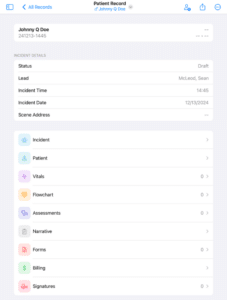
EHR | Stryker LP35 Beta
In Q4, we started beta testing the LIFEPAK 35, a brand-new ESO EHR cardiac monitor integration that receives transmissions through Stryker’s LIFENET API. The ability to import data from the monitor to ESO EHR reduces documentation time while improving the accuracy of your data, allowing you to better focus on the delivery of care. This new integration is now available to all ESO EHR users.
As technology modernizes in the field, ESO EHR will continue to advance its integrations to better support your needs, including the upcoming capability of importing 15-lead ECG waveform images.
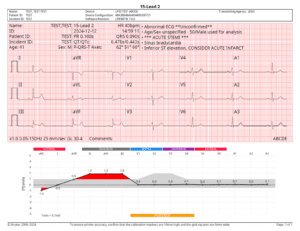
EHR | MIH / Community Paramedicine Run Type
Mobile Integrated Health (MIH)/Community Paramedicine has been added to ESO EHR to better support the unique workflow requirements of agencies that document MIH/CP visits. This run type and its required fields will streamline state submissions by removing many of the configurable validation requirements while giving you the tools necessary to manage your MIH/Community Paramedicine program’s unique documentation and reporting needs.
EHR | FLACC Pain Scale
The FLACC Pain Scale was part of our Critical Care initiative in 2024 and will be available in the Pain section within Vitals in ESO EHR. You can use it to directly document and upload FLACC Pain Scores and final score data for non-verbal patients into ESO Insights for easier reporting.
EHR | GenAI Narrative Web Beta Release
Currently in beta, the new GenAI Narrative Web feature for ESO EHR allows you to request an auto-generated Narrative on a PCR, streamlining data entry while improving focus on care. The first phase of our Auto-Generated Narrative uses the DCHARTE format, which allows you to request AI-generated narratives for Transport records with a “transport by this EMS unit” disposition.
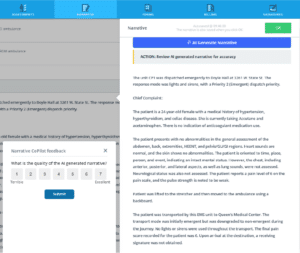
Our beta period will extend through the beginning of February. So far, customer feedback has been promising, and we will continue to collect and incorporate feedback throughout this period. This feature will be available to all customers on ESO EHR before Wave 2025.
Logis Dispatch | Voice Platform
A complete rewrite of the Logis Voice platform has been finalized and is now live with the first customer! The rewrite features a complete architectural makeover, client-side experience, and full ESO Chat functionality. Support for various phone systems will also be included in an upcoming phase.
Logis Dispatch | AVL Subscription API
The Logis Dispatch IDS API now includes the ability to subscribe to Automatic Vehicle Location (AVL) feeds. This enables you to perform live updates through webhooks in any system integrated into Logis Dispatch.
Logis Billing | Automation and Integrations
The ESO team was hard at work adding more automation and logic to the Billing solution, including:
- A new Payor Matrix feature that acts as a payor decision tree will further reduce the headache of incorrect payor denials. New integrations were added to enable bi-directional interactions with WayStar for insurance verification and discovery and Artiva for third-party patient invoice management. You can also now streamline frequent tasks by assigning hotkeys to your ten most-used functions.
- New configurations allow you to assign and report on workers’ claims for the Office of Worker’s Compensation (OWCP), assign provider numbers (Taxonomy) to service types to help reduce backend denials related to the services provided, and automate narrative generation and emergency statement form assignments based on payor rules and regulations through newly added narrative templates.
- Lastly, you’ll find updated logic that helps you identify and accept exceptions presented on manual 835 flat file imports, enhanced task views that assist with queue management and follow-up project preparation, updated contractual adjustments related to bundles and denials, and an automatic printing of ePCRs with paper CMS 1500 (HCFA) forms.
Fire Incidents | NERIS Update
Since late 2023, ESO has been actively working with FEMA and their contractor, UL (FSRI), to help you prepare for the transition to the National Emergency Response Information System (NERIS). In Q4 2024, FEMA delivered the final v.1 of the Phase 1 schema and a draft of the validation rules for incident reporting, which allowed us to validate some assumptions in our planning and adjust for future expansions of the rules. Our development team has been hard at work implementing our solution for NERIS with the goal of having a basic NERIS-compliant version of Fire Incidents ready for beta testing by the end of Q1 2025.
This basic version will not include auto-import configuration and integrations with CAD and EHR will not be added until upcoming releases in 2025. For more information, visit our FAQs About NERIS.
Hydrants | External API
Your Fire Data API subscription now includes a new external, bidirectional Hydrants API! This API provides direct, real-time access to hydrant data and allows for third-party integrations that make it easier to share your ESRI account with your water department and display shared hydrant and hydrant task data.
Hydrant records, including location, status, inspection and maintenance history, task scheduling, etc., can now be updated using the available API endpoints. To learn how to use the Hydrants API, head to the ESO API Developer portal.
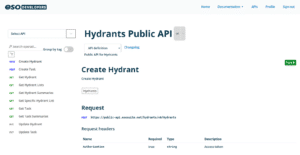
Permits | External API
A new external, bi-directional Permits API is now included in your Fire Data API Subscription. This API provides direct, real-time access to permit data, including type, status, fee, applicant, etc., which you can then update through available API endpoints. Head to the ESO API Developer portal to learn how to use your Permits API.
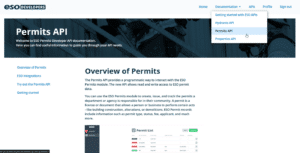
Public APIs allow us to incorporate the third-party services that improve your current ESO offerings and, in turn, improve your day-to-day workflows.
HDE | EMPI Matches
We have enhanced HDE EMPI matching to ensure that all units responding to an incident now qualify for an EMPI match rather than just a singular EMS record, which is what was previously eligible. This update guarantees that each of your responding units will be processed through our EMPI system, which is particularly crucial in regions with high first responder EHR utilization, such as Napa Valley and Monterey County in California and Providence Healthcare in Washington.
PM | Pay Rates
You can now track individual pay rate history on both PM Basic and purchased PM by heading to team members’ personnel records located in the Pay Rate section of the new Work Performance tab. You can also manage the complete list of hourly and flat rate pay rates by heading to PM > Settings. To enable this functionality, visit PM > Settings > Enable Add-Ons.
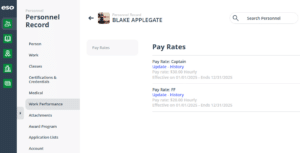
Pay Rates are available for any customer and are a prerequisite for the upcoming Compensation module. This new module will allow payroll calculations for volunteer and combination departments, as well as departments who have a pay-per-call model where personnel are paid by response.
PM | New Classes Insights Dashboards
Two new dashboards are available in Insights for PM! “Training Sessions and Duration by Personnel” is a global dashboard for customers who do not use credit hours and points for training classes and would prefer to calculate and record time based on session length.
The second dashboard, “PM – Classes – Quality Control,” will allow you to identify sessions with missing information (such as credits, instructors, or attendees) through a new quick selector bar graph and summary tables.
Activities | Edit Operational Tasks
This long-awaited Activities improvement will allow users with the appropriate security permissions to edit the fields of any completed operational task, including status. An audit trail located in the record will capture all changes made.
Checklists | New Meter Reading Fields
Based on your feedback, two additional meter reading fields have been added to Checklists: Aerial Hours and Generator Hours. These new options are now included in the editing process and, if enabled, will be available to your crew during checklist submissions.
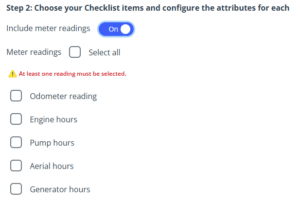
Assets | Maintenance & Asset Profile Updates
Several Asset updates were made in Q4, setting the stage for new Preventive Maintenance features coming in early 2025. Vehicle and equipment profile pages will now feature meter reading fields that can either be manually updated or automatically updated through Checklist submissions. We’ve also improved data storage to better support your Preventive Maintenance reminders and overall reporting experience.
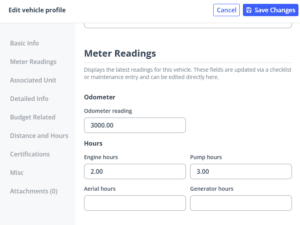
Meter reading fields have also been added to the Maintenance Request, along with view-only Created By and Created Date/Time fields, and the ability to set a vehicle back as in-service after the request is completed.
Scheduling | Comp Time Enhancements
Based on your feedback, administrators can now disable Schedule Conflicts for the Comp Time and Accrued Comp Time item types. This will allow schedulers to reflect the comp time used or accrued by employees while having a standard paid shift on the schedule.
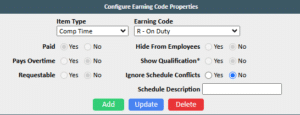
ODL – New PM and Assets Courses
Keep an eye out for two new On-Demand Learning (ODL) courses. “Personnel Management – Basic Setup and Use” is a refresh to the PM Basic course and is broken down into 14 short video modules designed to help you quickly find any information you need while making content more accessible. “Assets – Location Management” gets admin users up to speed on new Location Management features while also teaching them how to create, manage, archive, and organize locations and sublocations in Assets.
Insights | Dashboards
Our designers have been very busy this quarter building 48 new dashboards across the entire ESO Suite! Here’s a quick breakdown by product:
| Related Application | Number of New Dashboards |
| Patient Registry | 38 |
| Fire Incidents | 5 |
| Trauma Repository | 3 |
| EHR | 2 |
Cross-Product / ESO Suite | In-App Enhancements
In Q4, ESO received 1,646 enhancement suggestions from our community, and we have triaged and replied to 80.9% of those suggestions. We will continue to email you updates when viable ideas progress into the discovery, design, and development stages.
Our team worked on the next evolution of improving feedback throughout our software design and development process to ensure we are building exactly what your teams need. Our new Ideas Portal will be under tabs and mirror our Roadmap’s design and development stages:
- Now = Newly released features and updates
- Next = Works in progress with a delivery timeline
- Later = Ideas that are committed to the roadmap, but the timeline remains unknown
- Under Consideration = Ideas being actively investigated for feasibility
Look out for our pilot launch in Personnel Management early in Q1.
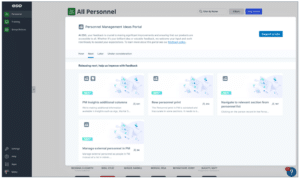
What to expect in Q1/25?
We have a few more exciting improvements in the works for Q1 2025. Please stay tuned for release notes and the next product blog, but here’s a sneak preview of upcoming updates and enhancements:
EMS
- EHR iOS GA
- Physio LP35 Integration GA
- Longitudinal Records for iOS and Windows Mobile
- EHR Web AI Generative Narrative – 1st Release
Fire
- GIS/Mapping (Properties Grid)
- Hydrants Bulk Actions
Shared Apps
- Scheduling – Shift Swap Refresh
- Assets – Preventive Maintenance Foundations
- PM – Compensation (Payroll for Vol/Combo) Phase 1
Hospital
- Compliance Matrix Tooling enhancements
- Cerner FHIR Integration
Cross-Product / ESO Suite
- A brand-new login screen and features
- Launching in early Q1, the Resource Center for Personnel Management will feature an ‘Ideas Portal’ pilot that will share ideas currently in various stages of design and development. To access it, click on the red notification in the Personnel Management Resource Center, which you can locate by clicking on the blue question mark in the bottom right-hand corner.
- If the ‘Ideas Portal’ pilot is a successful means of gaining more valuable feedback, we plan to launch a portal for each of our Resource Centers by the end of Q1. Please check it out and give us feedback on the value of the ideas presented.
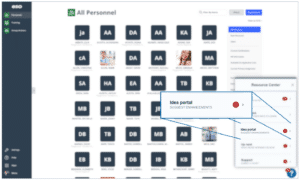
About Product Management at ESO
The ESO Product Management is responsible for creating the Product Roadmap, which outlines what products, features, and functionalities we will build next. Through daily collaboration with support, sales, customer success, industry experts, and, most importantly, customers like you, our team works hard to create the best apps possible to advance our mission of improving community health and safety through the power of data.
Over the past year, we’ve invested in world-class tools that allow us to capture customer product feedback at scale and, in turn, make more informed roadmap decisions. These tools enable us to quickly test ideas to deliver the most valuable features to you. We value your input and hope you continue to engage with us through our continuously expanding in-app capabilities
Want to look at the progress made on the ESO Product Roadmap in 2024? Check out the three previous ESO Updates Quarterly Product Enhancements blog posts below.
The post (Q4/2024) ESO Updates: Quarterly Product Enhancements appeared first on ESO.
]]>